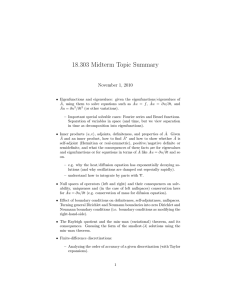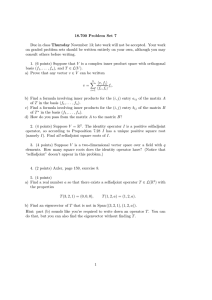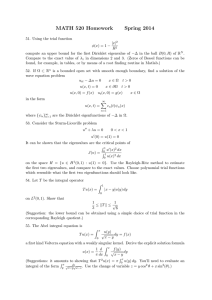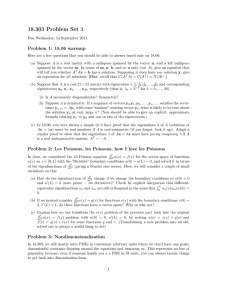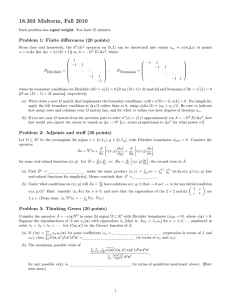Document 10767369
advertisement
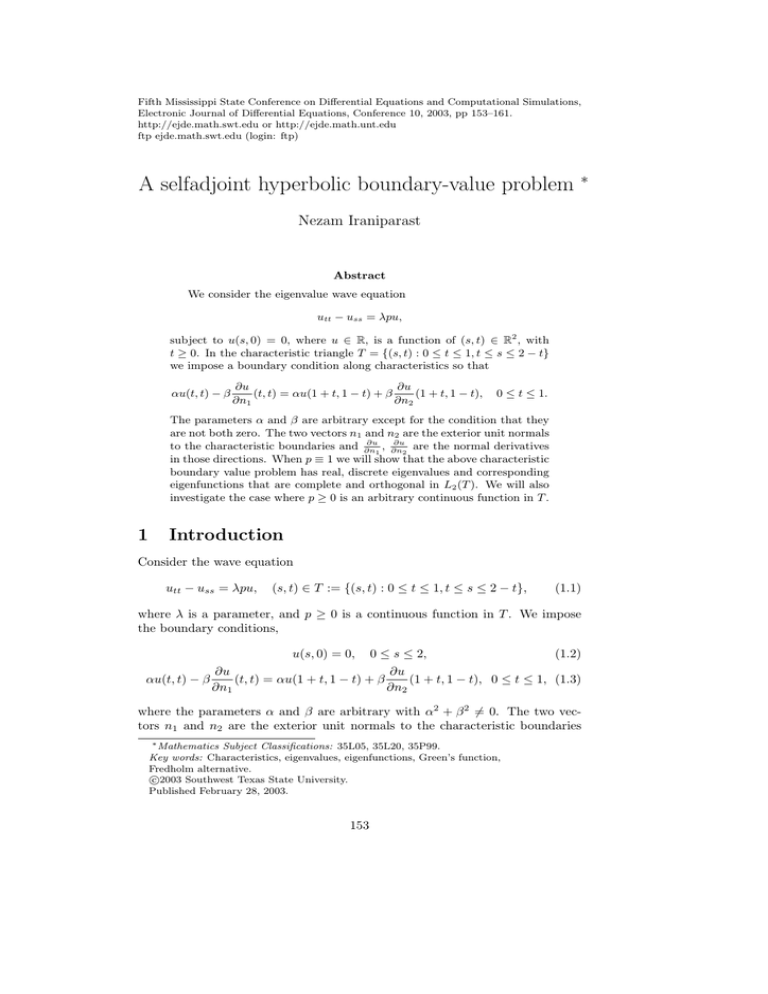
Fifth Mississippi State Conference on Differential Equations and Computational Simulations,
Electronic Journal of Differential Equations, Conference 10, 2003, pp 153–161.
http://ejde.math.swt.edu or http://ejde.math.unt.edu
ftp ejde.math.swt.edu (login: ftp)
A selfadjoint hyperbolic boundary-value problem
∗
Nezam Iraniparast
Abstract
We consider the eigenvalue wave equation
utt − uss = λpu,
subject to u(s, 0) = 0, where u ∈ R, is a function of (s, t) ∈ R2 , with
t ≥ 0. In the characteristic triangle T = {(s, t) : 0 ≤ t ≤ 1, t ≤ s ≤ 2 − t}
we impose a boundary condition along characteristics so that
αu(t, t) − β
∂u
∂u
(t, t) = αu(1 + t, 1 − t) + β
(1 + t, 1 − t),
∂n1
∂n2
0 ≤ t ≤ 1.
The parameters α and β are arbitrary except for the condition that they
are not both zero. The two vectors n1 and n2 are the exterior unit normals
∂u
∂u
to the characteristic boundaries and ∂n
, ∂n
are the normal derivatives
1
2
in those directions. When p ≡ 1 we will show that the above characteristic
boundary value problem has real, discrete eigenvalues and corresponding
eigenfunctions that are complete and orthogonal in L2 (T ). We will also
investigate the case where p ≥ 0 is an arbitrary continuous function in T .
1
Introduction
Consider the wave equation
utt − uss = λpu,
(s, t) ∈ T := {(s, t) : 0 ≤ t ≤ 1, t ≤ s ≤ 2 − t},
(1.1)
where λ is a parameter, and p ≥ 0 is a continuous function in T . We impose
the boundary conditions,
u(s, 0) = 0, 0 ≤ s ≤ 2,
(1.2)
∂u
∂u
αu(t, t) − β
(t, t) = αu(1 + t, 1 − t) + β
(1 + t, 1 − t), 0 ≤ t ≤ 1, (1.3)
∂n1
∂n2
where the parameters α and β are arbitrary with α2 + β 2 6= 0. The two vectors n1 and n2 are the exterior unit normals to the characteristic boundaries
∗ Mathematics Subject Classifications: 35L05, 35L20, 35P99.
Key words: Characteristics, eigenvalues, eigenfunctions, Green’s function,
Fredholm alternative.
c
2003
Southwest Texas State University.
Published February 28, 2003.
153
154
A selfadjoint hyperbolic boundary-value problem
EJDE/Conf/10
∂u
∂u
and ∂n
, ∂n
are the normal derivatives in those directions. Our problem is a
1
2
generalization of the problems studied by Kalmenov [6], and Kreith [7], where
they consider the boundary conditions,
u(s, 0) = 0 = u(1, 1), 0 ≤ s ≤ 2
u(t, t) = u(1 + t, 1 − t), 0 ≤ t ≤ 1.
We note two facts. First, if we only prescribe the values of u along the characteristics, say, u(t, t) = f1 (t) and u(1 + t, 1 − t) = f2 (t) then we have a classical
characteristic initial value problem,(see, e.g., Garabedian [1]) and equation (1.1)
will have a solution for all values of λ. However, the conditions (1.2), (1.3) provide a boundary value problem with spectral properties. Second, if we set β = 0
in condition (1.3) we have the case of Kreith [7] . If in addition, we set p ≡ 1 we
have the case of Kalmenov [6]. As a start we will let p ≡ 1 and use the technique
of Kalmenov [6] to show that the equation, utt − uss = λu, (s, t) ∈ T subject
to conditions (1.2), (1.3), is selfadjoint. Then we will study equation (1.1) subject to conditions (1.2), (1.3) by converting the problem into a nonhomogeneous
eigenvalue integral equation and using the method of the Fredholm alternative.
In this case we will assume that u along the characteristics is given. This will
not weaken the problem because we still require that condition (1.2) be satisfied.
As a result we will see that not all values of λ will produce a solution.
We would like to add here that the investigation into the spectral properties of the characteristic initial value problems for the wave equation has been
conducted in different directions by several authors. In this context, beside the
above mentioned references, the works of Haws [2], Kreith [8, 9] and the author
[3, 4, 5] are the ones most closely related to the present work.
2
The selfadjoint problem
Consider the equation
utt − uss = λu,
(s, t) ∈ T,
(2.1)
subject to the conditions (1.2), (1.3). Extend u as an odd function of t and
define,
(
u(s, t)
if t > 0, (s, t) ∈ T
ũ(s, t) =
−u(s, −t) if t < 0, (s, −t) ∈ T
and reflect T in t = 0 axis to obtain the rectangle
R = {(s, t) : |t| ≤ 1, |t| ≤ s ≤ 2 − |t|}.
(2.2)
Now ũ must satisfy the following conditions:
ũtt − ũss = λũ,
(s, t) ∈ R,
∂ ũ
∂ ũ
(t, t) = αũ(1 + t, 1 − t) + β
(1 + t, 1 − t),
αũ(t, t) − β
∂n1
∂n2
ũ(s, t) = −ũ(s, −t), (s, t) ∈ R.
(2.3)
|t| ≤ 1,
(2.4)
(2.5)
EJDE/Conf/10
Nezam Iraniparast
155
Using the change of variables, x = s − t, y = s + t and denoting ũ(s, t) =
y−x
ũ( x+y
2 , 2 ) by Ũ (x, y), the rectangle R maps into S = {(x, y) : 0 ≤ x ≤ 2, 0 ≤
y ≤ 2}, and we have,
−4Ũx,y = λŨ ,
(x, y) ∈ S,
(2.6)
αŨ (0, y) + β Ũx (0, y) = αŨ (y, 2) + β Ũy (y, 2),
(2.7)
Ũ (x, y) = −Ũ (y, x).
(2.8)
From this equation, we have Ũx (x, y) = −Ũy (y, x); therefore,
Ũ (0, y) = −Ũ (y, 0)
(2.9)
Ũx (0, y) = −Ũy (y, 0).
(2.10)
These two identities change the boundary condition (2.7) to,
−αŨ (y, 0) − β Ũy (y, 0) = αŨ (y, 2) + β Ũy (y, 2).
(2.11)
Now let Ũ (x, y) = φ(x)ψ(y), and plug it into equation (2.6), we have,
[2iφ0 (x)][2iψ 0 (y)] = λφ(x)ψ(y)
which leads to
(2.12)
2iφ0 (x)
ψ(y)
=λ
= µ,
φ(x)
2iψ 0 (y)
which in turn leads to two ODE equations:
ψ 0 (y) = −
iλ
iδ
λ
ψ(y) = − ψ(y), δ = ,
2µ
2
µ
iµ
φ0 (x) = − φ(x).
2
µ 6= 0,
(2.13)
(2.14)
The effect of separation of variables on the boundary condition (2.11) will be
−αφ(y)ψ(0) − βφ(y)ψ 0 (0) = αφ(y)ψ(2) + βφ(y)ψ 0 (2).
(2.15)
Upon cancelling φ(y) here, we have the boundary-value problem
iδ
ψ(y), 0 ≤ y ≤ 2,
2
−αψ(0) − βψ 0 (0) = αψ(2) + βψ 0 (2).
ψ 0 (y) = −
(2.16)
(2.17)
We note that from (2.16) we have
iδ
ψ(0),
2
iδ
ψ 0 (2) = − ψ(2).
2
ψ 0 (0) = −
(2.18)
(2.19)
156
A selfadjoint hyperbolic boundary-value problem
EJDE/Conf/10
These relations simplify the condition (2.17) to
ψ 0 (0) = −ψ(2),
(2.20)
The selfadjoint boundary-value problem (2.16), (2.20) is the same as the one in
[6]. The eigenvalues and eigenfunctions of problem (2.16), (2.20) are
δ = (−2n − 1)π,
ψn (y) = exp(
(2n + 1)πiy
),
2
n = 0, ±1, ±2, . . .
(2.21)
Using (2.8) differently to write Ũy (x, y) = −Ũx (y, x),
Ũ (y, 2) = −Ũ (2, y)
(2.22)
Ũy (y, 2) = −Ũx (2, y).
(2.23)
The substitution of (2.22), (2.23) into the boundary condition (2.7) yields
αŨ (0, y) + β Ũx (0, y) = −αŨ (2, y) − β Ũx (2, y).
(2.24)
If we again use the separation of variables Ũ (x, y) = φ(x)ψ(y) in the equation
(2.24) and proceed as for the case of the function ψ(y), we will have
iµ
φ(x), 0 ≤ x ≤ 2,
2
−αφ(0) − βφ0 (0) = αφ(2) + βφ0 (2).
φ0 (x) = −
(2.25)
(2.26)
The condition (2.26) again can be replaced with
φ0 (0) = −φ(2),
(2.27)
The eigenvalues and eigenfunctions of problem (2.25), (2.27) are
(2m + 1)πix
), m = 0, ±1, ±2, . . . (2.28)
2
Both sets of eigenfunctions {ψn (y)} and {φm (x)} are complete and orthogonal
in L2 (0, 2). The eigenfunctions and the eigenvalues of (2.6)–(2.8) will be
µ = (−2m − 1)π,
φm (y) = exp(
λmn = (2m + 1)(2n + 2)π 2 ,
(2.29)
(2m + 1)x (2n + 1)y
+
)πi, m, n = 0, ±1, ±2, . . .
2
2
To find the eigenfunctions of the problem (1.1)–(1.3), we introduce the functions
Ũmn (x, y) = exp(
umn (x, y) = Ũmn (x, y) − Ũmn (y, x)
(2m + 1)x (2n + 1)y
+
)πi
(2.30)
2
2
(2m + 1)y (2n + 1)x
− exp(
+
)πi,
2
2
for m, n = 0, ±1, ±2, . . . . The set {umn (x, y)} is complete and orthogonal in
L2 (T 0 ) where T 0 = {(x, y) : 0 ≤ y ≤ 2, 0 ≤ x ≤ y}.
= exp(
Theorem 2.1 Problem (1.1)–(1.3) when p ≡ 1 is selfadjoint. It has eigenvalues (2.29) and eigenfunctions (2.30). The eigenfunctions are complete and
orthogonal in L2 (T ).
EJDE/Conf/10
3
Nezam Iraniparast
157
The non-selfadjoint problem
Now consider the problem (1.1)–(1.3) and make the change of variables x = s−t
and y = s + t, to obtain
Uxy = γP (x, y)U (x, y), (x, y) ∈ T 0 ,
T 0 = {(x, y) : 0 ≤ y ≤ 2, 0 ≤ x ≤ y}
αU (0, y) + βUx (0, y) = αU (y, 2) + βUy (y, 2), 0 ≤ y ≤ 2
U (x, x) = 0, 0 ≤ x ≤ 2,
(3.1)
(3.2)
(3.3)
(3.4)
y−x
x+y y−x
where U (x, y) = u( x+y
2 , 2 ), P (x, y) = p( 2 , 2 ), and γ = −λ/4. Integrat0
ing (3.1) in T from 0 to ξ, we have
Z ξ
Uy (ξ, y) − Uy (0, y) = γ
P U dx.
(3.5)
0
The above equation when ξ = y and y = 2 will be
Z y
Uy (y, 2) − Uy (0, 2) = γ
P (x, 2)U (x, 2) dx.
(3.6)
0
Integrating equation (3.1) in T 0 from y to η, we have
Z η
Ux (x, η) − Ux (x, y) = γ
P U dy.
y
When x = 0 and η = 2 this equation becomes
Z 2
Ux (0, 2) − Ux (0, y) = γ
P (0, y)U (0, y) dy.
(3.7)
y
In (3.5) let ξ lie on the line y = x and integrate the equation from ξ to η in T 0 ,
Z ηZ ξ
P U dxdy.
(3.8)
U (ξ, η) − U (ξ, ξ) − U (0, η) + U (0, ξ) = γ
ξ
0
Since U (ξ, ξ) = 0 by the boundary condition (3.4), we have
Z ηZ ξ
U (ξ, η) = U (0, η) − U (0, ξ) + γ
P U dx dy .
ξ
(3.9)
0
From (3.6) when y is replaced with η we have
Z η
Uy (η, 2) = Uy (0, 2) + γ
P (x, 2)U (x, 2) dx.
(3.10)
0
From (3.7), when y is replaced with η we have
Z 2
Ux (0, η) = Ux (0, 2) − γ
P (0, y)U (0, y) dy.
η
(3.11)
158
A selfadjoint hyperbolic boundary-value problem
EJDE/Conf/10
Finally from equation (3.9) we have,
Z
2
Z
η
U (η, 2) = U (0, 2) − U (0, η) + γ
P U dx dy .
η
(3.12)
0
Now, we substitute the right hand side of the equations (3.10), (3.11), (3.12)
into the boundary condition (3.3) with y replaced with η,
2
Z
αU (0, η) + β(Ux (0, 2) − γ
P (0, y)U (0, y)dy)
η
2
Z
η
Z
= α(U (0, 2) − U (0, η) + γ
P U dx dy) + β(Uy (0, 2)
η
Z
+γ
0
η
P (x, 2)U (x, 2)dx).
0
Placing αU (0, η) in right-hand side and combining,
Z
2
2αU (0, η) + β(Ux (0, 2) + γ
P (0, y)U (0, y)dy)
η
2
Z
η
Z
= α(U (0, 2) + γ
P U dx dy) + β(Uy (0, 2)
η
(3.13)
0
η
Z
+γ
P (x, 2)U (x, 2)dx).
0
Rewrite this equation with η replaced with ξ,
Z
2αU (0, ξ) + β(Ux (0, 2) + γ
2
P (0, y)U (0, y)dy)
ξ
2
Z
ξ
Z
= α(U (0, 2) + γ
P U dx dy) + β(Uy (0, 2)
ξ
Z
+γ
(3.14)
0
ξ
P (x, 2)U (x, 2)dx).
0
Subtract equation (3.14) from (3.13),
2
Z
2α(U (0, η) − U (0, ξ)) + βγ(
Z
η
Z
= αγ(
2
η
Z
Z
2
Z
+ βγ(
0
0
η
P (0, y)U (0, y)dy)
ξ
Z
P U dxdy −
η
2
P (0, y)U (0, y)dy −
ξ
P U dx dy)
ξ
0
Z
P (x, 2)U (x, 2)dx −
ξ
P (x, 2)U (x, 2)dx).
0
(3.15)
EJDE/Conf/10
Nezam Iraniparast
159
Solve for U (0, η) − U (0, ξ) in (3.15), assuming α 6= 0, and substitute in (3.9),
Z 2
Z 2
β
U (ξ, η) = −
γ(
P (0, y)U (0, y)dy −
P (0, y)U (0, y)dy)
2α
ξ
η
Z 2Z η
Z 2Z ξ
γ
+ (
P U dx dy −
P U dx dy)
2 η 0
ξ
0
(3.16)
Z η
Z ξ
β
+
γ(
P (x, 2)U (x, 2)dx −
P (x, 2)U (x, 2)dx)
2α
0
0
Z ηZ ξ
+γ
P U dx dy .
ξ
0
Rewrite (3.16) in a compact form using the Green’s function, G(ξ, η; x, y) described in Figure 1,
Z Z
U (ξ, η) =γ(
G(ξ, η; x, y)P U (x, y) dx dy
T0
(3.17)
Z 2
g(ξ, η, x)(P (0, x)U (0, x) − P (x, 2)U (x, 2))dx),
−
0
where
if 0 ≤ x ≤ ξ
0
g(ξ, η, x) = β/(2α) if ξ ≤ x ≤ η
0
if η ≤ x ≤ 2
Now, let G be the operator,
Z Z
G[U ] =
G(ξ, η; x, y)P U (x, y) dx dy
(3.18)
T0
defined on the Hilbert space of weighted square integrable functions H =
0
LP
2 (T ). Assume the function U along the characteristics x = 0 and y = 0
0
in T is given, and denote,
Z 2
f (ξ, η) =
g(ξ, η, x)(P (0, x)U (0, x) − P (x, 2)U (x, 2))dx.
(3.19)
0
Also, let Γ = 1/γ when γ 6= 0. Then, (3.13) can be written as
G[U ] = ΓU + f.
(3.20)
The operator G in (3.18), is the same as the one in [7], where it is shown to
be selfadjoint in H. Denote the normalized eigenfunctions of G by Ek , and the
inner product in H by h., .i. Using the standard Fredholm alternative [10] we
have the following theorem.
Theorem 3.1 Let Γk be the eigenvalues of GU = ΓU , where by the selfadjointness of G, are real and satisfy |Γk | → 0, as k → ∞ then, we have
160
A selfadjoint hyperbolic boundary-value problem
EJDE/Conf/10
y
2
0
z
0-
1/2
w
-0
1/2
0-
-
w
z
2
x
Figure 1: The Green’s function G(w, z; x, y)
1. Γ 6= Γk for any integer P
k. A unique solution of (3.20) exists and is given
in the form U = − Γf + k Γ(ΓΓkk−Γ) hf, Ek iEk .
2. Γ = Γm , one of the eigenvalues of G, and Γm is not degenerate. If
hf, Em i =
6 0 the equation (3.20) has no solution. If hf, Em i = 0 then,
(3.20) has infinitely many solutions
U =−
X
f
Γk
+
hf, Ek iEk + cEm ,
Γm
Γm (Γk − Γm )
k6=m
with c an arbitrary constant.
3. Γm is degenerate, Γm1 = Γm2 = · · · = Γmj , for successive indices m1 ,
m2 ,. . . mj , with some mi = m, i = 1, 2, . . . j, where j is the multiplicity
of Γm . Then, unless hf, Ei i = 0, i = 1, 2, . . . , j, the equation (3.20) has
no solution. If however, these j solvability conditions are satisfied, the
solution can be represented by,
U =−
j
X
X
f
Γk
+
hf, Ek iEk +
ci Emi ,
Γm
Γm (Γk − Γm )
i=1
k6=mi
where ci ’s are arbitrary constants.
Remark When p ≡ 1 in problem (1.1)–(1.3), the problem is selfadjoint if
α2 + β 2 6= 0. When p is not necessarily 1, the case α 6= 0, β = 0, reduces the
problem to the selfadjoint problem of [7]. When α 6= 0, β 6= 0, Theorem 2 holds.
When α = 0, no conclusion can be drawn.
EJDE/Conf/10
Nezam Iraniparast
161
References
[1] P. Garabedian. Partial differential equations. Second edition, Chelsea Publishing Co., New York, 1986. vxii+672 pp. ISBN: 0-8284-00325
[2] L. Haws. Symmetric Green’s functions for certain hyperbolic problems,
Comput. Math. Appl. 21 (1991), no. 5, 65–78.
[3] N. Iraniparast. A method of solving a class of CIV boundary value problems,
Canad. Math. Bull. 35 (1992), no. 3, 371–375.
[4] N. Iraniparast. A boundary value problem for the wave equation. Int. J.
Math. Math. Sci. 22 (1999), no. 4, 835–845.
[5] N. Iraniparast. A CIV boundary value problem for the wave equation, Appl.
Anal. 76 (2000), no. 3-4, 261–271.
[6] T. Kalmenov. On the Spectrum of a Selfadjoint Problem for the Wave Equation, Akad. Nauk. Kazakh. SSR, Vestnik 1 (1983), 63-66.
[7] K. Kreith. Symmetric Green Functions for a Class of CIV Boundary Value
Problems, Canadian Math. Bull. 31 (1988), 272-279.
[8] K. Kreith. Mixed selfadjoint boundary conditions for the wave equation, Differential equations and its applications (Budapest, 1991), 219–226, Colloq.
Math. Soc. Janos Bolyai, 62, North-Holland, Amsterdam, 1991.
[9] K. Kreith. Establishing hyperbolic Green’s functions via Leibniz’s rule,
SIAM Rev. 33 (1991), no. 1, 101–105.
[10] I. Stakgold. Green’s Functions and Boundary Value Problems, John Wiley
& Sons, New York, 1979.
Nezam Iraniparast
Department of Mathematics
Western Kentucky University
E-mail: nezam.iraniparast@wku.edu
